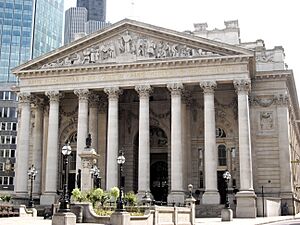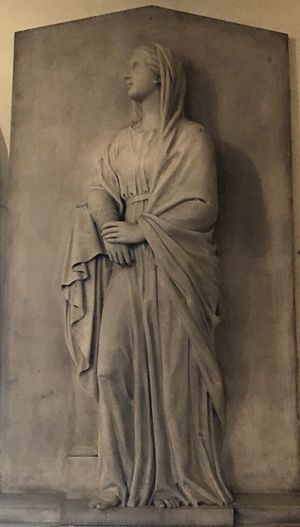Richard Westmacott (the younger) facts for kids
Richard Westmacott (born April 14, 1799, died April 19, 1872) was an important English sculptor. He lived in the early and middle 1800s. People sometimes called him Richard Westmacott III. This was to tell him apart from his father and grandfather, who were also famous sculptors with the same name.
A Sculptor's Journey

Richard Westmacott was born in London. He followed in his father's footsteps, just like his father followed his grandfather's. All three were sculptors!
Richard studied at the Royal Academy starting in 1818. This is a famous art school in London. He became an Associate of the Royal Academy in 1838. Later, in 1849, he became a full Academician. An Academician is a top member of the Royal Academy.
After his father, Sir Richard Westmacott, retired, Richard took over his job. From 1857 to 1868, he was the professor of sculpture at the Royal Academy. This was the only time a father and son both held this important teaching role.
Famous Sculptures and Monuments
One of Richard Westmacott's most famous works is the large sculpture on the front of the Royal Exchange building in London. This type of sculpture is called a pediment.
Other important works by Richard Westmacott include:
- A tomb for Philip Yorke, 3rd Earl of Hardwicke at St Andrew's Church in Wimpole, Cambridgeshire.
- A monument remembering Sir John Franklin's lost trip to the Arctic in 1845. This is now at Greenwich Hospital in London.
- A monument for Chief Justice Sampson Salter Blowers at St. Paul's Church in Halifax, Nova Scotia.
In May 1837, Richard Westmacott was chosen to be a Fellow of the Royal Society. This is a group of very smart people who are interested in science. He was recognized for his work as a sculptor and for writing about art and old things.
Today, there is a special memorial for him. You can find it in St Mary Abbots church in Kensington, west London.
Notable Works by Richard Westmacott

Richard Westmacott created many public sculptures. These are some of his well-known pieces:
- A monument for William Burslem in 1820 at Worcester Cathedral.
- A monument for Sacharissa Hibbert in 1828 at Exeter Cathedral.
- A bust of Sir William Sidney Smith in 1829. A bust is a sculpture of a person's head and shoulders.
- A monument for Bishop George Pretyman Tomline in 1830 at Winchester Cathedral.
- A bust of George Tierney in 1830 at Westminster Abbey.
- A bust of Davies Gilbert in 1833 at Pembroke College, Oxford.
- A bust of Rev Sydney Smith in 1835.
- A marble bust of Friedrich August Rosen in 1838, now at the British Museum.
- A bust of Cardinal Newman in 1841.
- Busts of Wibraham Egerton and his daughter in 1842 at Tatton Park, Cheshire.
- A bust of Lord John Russell in 1843 at Woburn Abbey.
- A bust of Sir Francis Burdett in 1845.
- A marble bust of John Edward Gray in 1845, also at the British Museum.
- A bust of Sir Roderick Murchison in 1847 at the Scottish National Portrait Gallery.
- A monument for Archbishop Howley in 1848 at Canterbury Cathedral. This sculpture shows him lying down.
- The tomb of Bishop Kaye in 1857 at Lincoln Cathedral. This also features a figure lying down.


